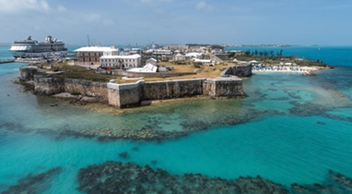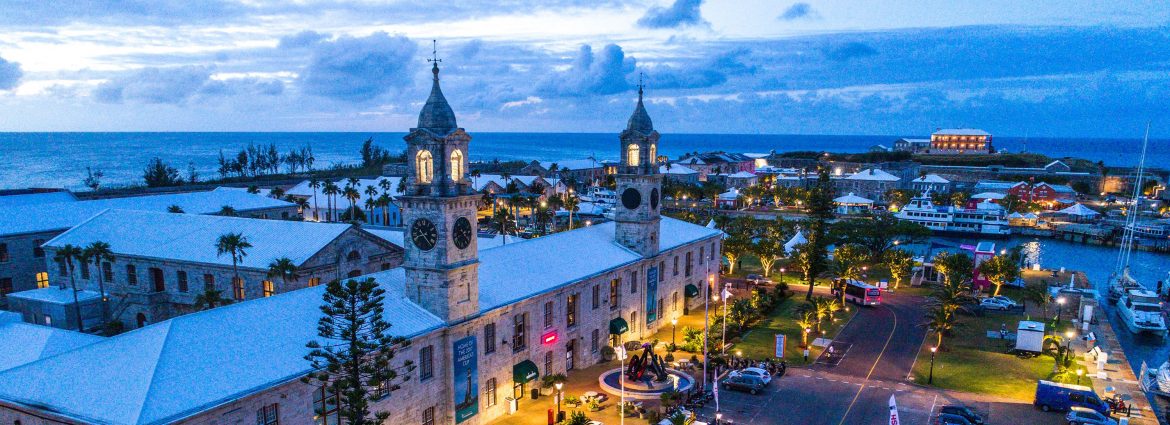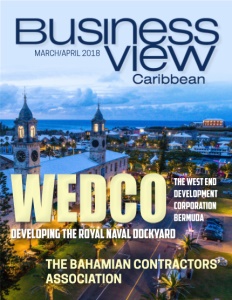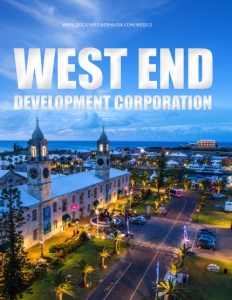West End Development Corporation
Developing the Royal Naval Dockyard
Business View Caribbean interviews representatives of the West End Development Corp., as part of our focus on best practices of Bermuda businesses.
The British Empire was built on the strength of its navy, and for eons, England was the most prominent seafaring power on earth. While English fighting vessels had roamed the seas since the 10th century, a standing “Navy Royal,” with its own purpose-built warships and dockyards, didn’t emerge until the reign of Henry VIII, half a millennium later. In 1588, Queen Elizabeth celebrated the British fleet’s victory over the Spanish Armada, and by the 17th century, the Navy had completed the transition from a semi-amateur fighting fleet of “gentlemen” (upper-class soldiers) and “tarpaulins” (professional seamen, who generally served on merchant or fishing vessels in peacetime) into a fully professional institution with an officer corps and a defined career structure.
 The Acts of Union, which created the Kingdom of Great Britain in 1707, also established the Royal Navy, which remained the world’s largest maritime force throughout the 18th and 19th centuries. During the American War of Independence (1775–1783), it easily obliterated the small Continental Navy of frigates fielded by the rebel colonists, but the entry of France, Spain, and the Netherlands into the war against Britain produced a combination of opposing forces which deprived the Navy of its position of superiority for the first time since the 1690s. That decisive defeat forced the retreating flotilla to establish a new, operational base between Halifax, Nova Scotia and the West Indies, two key remaining outposts of British rule – and Bermuda was quickly identified as the most strategic and secure location.
The Acts of Union, which created the Kingdom of Great Britain in 1707, also established the Royal Navy, which remained the world’s largest maritime force throughout the 18th and 19th centuries. During the American War of Independence (1775–1783), it easily obliterated the small Continental Navy of frigates fielded by the rebel colonists, but the entry of France, Spain, and the Netherlands into the war against Britain produced a combination of opposing forces which deprived the Navy of its position of superiority for the first time since the 1690s. That decisive defeat forced the retreating flotilla to establish a new, operational base between Halifax, Nova Scotia and the West Indies, two key remaining outposts of British rule – and Bermuda was quickly identified as the most strategic and secure location.
The Royal Navy purchased some 200 acres of land on the island’s west end, and in 1809, work began on the North America and West Indies Station and the Royal Naval Dockyard. It was from there, in the summer of 1814, that a British force of 5,000 troops and Royal Marines set sail for the famous attack on Washington, D. C. and Baltimore during the War of 1812. And it was from one of the British ships that a prisoner, Baltimore lawyer Francis Scott Key, penned the words to the Star-Spangled Banner, after seeing the American flag still flying above Fort McHenry after a heavy bombardment.
Over the course of time, the Royal Naval Dockyard became a major factor in Bermuda’s economy and an important center of marine technology, affording generations of Bermudians first-rate training in plumbing, carpentry, and other maritime trades. During the First World War (1914-18) and Second World War (1939-1945), it was a bustling, vibrant port with floating docks where ships were repaired for combat deployment.
The Royal Navy left the main Dockyard in 1951, and for the next two decades, the area was largely abandoned until the National Museum of Bermuda opened in 1974, and its success led the government to consider restoring the entire Royal Naval Dockyard as a cultural tourism destination. In 1982, Parliament passed the West End Development Corporation (WEDCO) Act, which set up a quasi-autonomous agency with the mandate to develop the area and repurpose all of its existing naval structures, while preserving their historical and architectural integrity.
Today, the Royal Naval Dockyard is the most visited site in Bermuda, underscoring the value of architectural heritage to the tourism industry. It is part of the West End Development Corporation’s mixed-use development – a combination of history and culture, arts and crafts, entertainment, retail shopping, restaurants and pubs, tourism, watersports, a marina, residences, and even some light industrial. “We’ve got a few areas that still need to be developed, but the majority of the buildings are complete,” says Joanna Cranfield, WEDCO’s Business Development Manager, “and it’s currently a thriving working and residential hub – and the historical integrity has been maintained, throughout.”
According to General Manager Andrew Dias, funding for the  $60 million project came primarily from the government, but also from tenants who lease property from WEDCO. “They also agree to fix up the area they are renting,” he explains. “We would do the exterior structure and they would do all of the interior. We have been responsible for providing the infrastructure, whether it be power, water, sewage, telecommunications, roads, even bringing, to some degree, the tourism to the area by having two of Bermuda’s largest cruise ships come to port, with over 90 percent of Bermuda’s passengers coming through the Royal Naval Dockyard. So, we’re providing commerce to entities that wish to invest in various businesses.”
$60 million project came primarily from the government, but also from tenants who lease property from WEDCO. “They also agree to fix up the area they are renting,” he explains. “We would do the exterior structure and they would do all of the interior. We have been responsible for providing the infrastructure, whether it be power, water, sewage, telecommunications, roads, even bringing, to some degree, the tourism to the area by having two of Bermuda’s largest cruise ships come to port, with over 90 percent of Bermuda’s passengers coming through the Royal Naval Dockyard. So, we’re providing commerce to entities that wish to invest in various businesses.”
That cruise population is essential to Bermuda’s economy. “With the entire population of the country being somewhere around 65,000, we have almost 10,000 coming off cruise ships, daily, from April through October/November,” says Ms. Cranfield. “And unlike Caribbean countries, when cruise ships come to Bermuda, they stay here for two nights and three days; they don’t just pop by in the morning and leave in the afternoon. It’s quite feasible for a cruise ship guest to visit the entire island during their stay.”
“We are unique in our cruise offerings in that we do stay longer in port,” Mr. Dias adds. “And that’s a relationship that we’ve built up with the cruise lines over the years. Tourism still remains a critical part of Bermuda’s industry and a major employment factor for Bermudians.”
In addition to continuing to oversee its existing facilities, both Mr. Dias and Ms. Cranfield report that WEDCO is always on the lookout for new businesses and tenants – only 50 percent of its over 200 acres is currently developed. “Part of our mandate is to manage the existing development, but we will always be tasked, to some degree, of adapting to whatever is new to keep this area vibrant,” says Mr. Dias. “And there will always be the need to expand. It could be new residences or anything at all. As long as we’re able to save the historical aspects of the Royal Naval Dockyard and we’re able to fit whatever the concept is, providing that it does not take away any of the historical attributes of the area.” “We have an open mind,” Ms. Cranfield declares. “We’re available to consider any and all options.”
Check out this handpicked feature on The Jamaica Business Development Corporation.
AT A GLANCE
WHO: West End Development Corporation
WHAT: A development and management company
WHERE: Sandys, Bermuda
WEBSITE: www.dockyardbermuda.com/wedco
PREFERRED VENDORS

Correia Construction – Correia Construction Company Ltd. is a family-owned and operated business with over 80 years of experience in technical design, project management, commercial building, demolition, and marine construction. The company owns, operates, and maintains a large fleet of equipment, from spud barges, tugboats, pile-driver rigs, cranes, work boats, excavators, tractor heads, heavy trucks, loaders, forklifts, hi-lifts and more. Its reputation for high quality service has come from the successful design and construction of Bermuda’s most challenging projects. – www.correiaconstruction.bm








 This information will never be shared to third parties
This information will never be shared to third parties